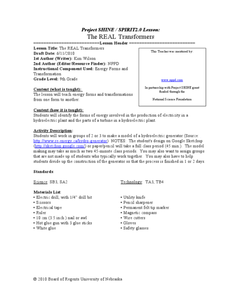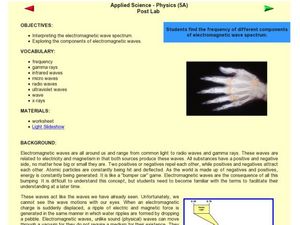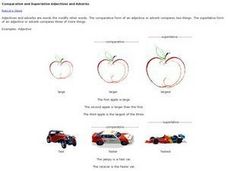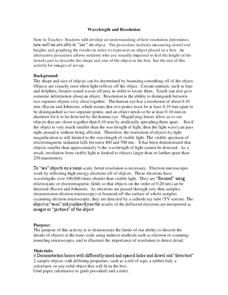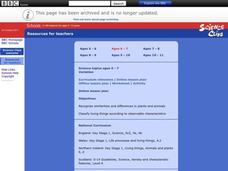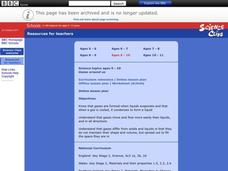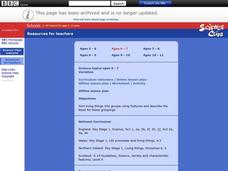Curated OER
Worksheet for Analysis of a Motion Picture
In this primary source analysis worksheet, high schoolers respond to 14 short answer questions that require them to analyze the motion picture of their choice.
Curated OER
Do Not Go Gentle into That Good Night Questions
In this reading comprehension worksheet, students respond to 5 short answer and essay questions based on the poem "Do Not Go Gentle into That Good Night."
Curated OER
Adjectives and Adverb Worksheet
In this adjective, adverb, and prepositions activity, students choose the correct word to complete the sentences and indicate if sentences are correct or not. Students complete
Curated OER
SPOTTING THE PARTS OF SPEECH
In this grammar worksheet, 4th graders identify the parts of speech. Students study 20 sentences denoting if the underlined word is a noun, verb, or an adjective. Students then write 18 sentences using a given word in its correct format.
Curated OER
The REAL Transformers
Ninth graders create a model of a hydroelectric generator. For this physics lesson, 9th graders discuss how energy can be transformed from one form to another. They make a flow chart for different energy generating plants.
Curated OER
Applied Science - Science and Math Pre Lab
Students explore human senses. In this applied Science lesson, students utilize their senses to distinguish various objects. Students explain their descriptions.
Curated OER
Electromagnetic Wave Spectrum
Fifth graders examine electromagnetic wave spectrum. In this science lesson, 5th graders discuss the aspects of the electromagnetic wave spectrum and complete a worksheet identifying the parts of the spectrum.
Curated OER
Comparative and Superlative Adjectives and Adverbs
In this comparative and superlative worksheet, students review rules and examples of comparative and superlative forms of adjectives and adverbs. Students then complete fill-in-the-bank, multiple choice, and other practice problems.
Curated OER
What Shape Is It?
Students predict the shape of an unknown object by bouncing a ball on it. In this physics lesson, students relate this activity to how dolphins use echo-location to navigate. They analyze their lab result and discuss findings.
Curated OER
Series and Parallel Circuits
Students examine electricity. In this circuits lesson students complete an activity that shows them the configuration of circuits.
Curated OER
Wavelength And Resolution
Students perform a simulation of the workings of an electron microscope to discover that the resolution will need to improved to detect objects in the nano-scale. They use wooden dowels as detectors to determine the shape of objects in...
Curated OER
The Rumblin' Road
Students determine the distance to a lightning strike. They complete a number of examples that determine the distance to a thunderstorm or lightning strike. They focus on safety during a thunderstorm.
Curated OER
Eerie Exits
Students recognize the short vowel e in written and spoken language. Through matching and listening activities, they discriminate the short vowel /e/ from other phonemes. Students associate the phoneme with its letter representation and...
Curated OER
Ourselves
Students use a website to name and compare external body parts of humans and other animals.
Curated OER
Moving and Growing
Students know that humans and some other animals have bony skeletons inside their body. They know that other animals have skeletons on the outside of their bodies. They explain the role of both kinds of skeletons.
Curated OER
Circuits and Conductors
Young scholars participate in an online lesson to explain the conductivity of different materials and the effect of changing the power source.
Curated OER
Variation
Students participate in an online lesson to reinforce the similarities and differences in plants and animals. They classify living things according to observable characteristics.
Curated OER
Gases Around Us
Learners participate in an online lesson showing that gases are formed when liquids evaporate and that when a gas is cooled, it condenses to form a liquid, and gases move and flow more easily than liquids, and how gases differ from solids.
Curated OER
Changing State
Students participate in an online lesson plan to investigate the effects of cooling and heating on water.
Curated OER
Micro-organisms
Young scholars examine how micro-organisms are living organisms that are often too small to be seen. They explain that micro-organisms may be beneficial or harmful.
Curated OER
Forces in Action
Learners ask questions that can be investigated scientifically. They determine how to plan a fair test by changing one factor while keeping other factors the same, to use measurements to draw conclusions and use scientific knowledge to...
Curated OER
Changing Circuits
Students participate in an online lesson to explain how to make bulbs brighter or dimmer in a series circuit by changing the number or type of components.
Curated OER
Variation
Students practice sorting living things into groups using their characteristics. Using pictures of leaves and animals, they sort them based on their color and shape and write the objects characteristics under the picture. They share...
Curated OER
Keeping Warm
Students place words describing a range from cold to hot on a scale. Using those words, they identify places on Earth which are cold, hot, freezing or boiling. They practice using and reading a thermometer with three different beakers...
Other popular searches
- Light and Sound Waves
- Light and Sound Energy
- Heat Light Sound Energy
- Sound and Light
- Physics Sound and Light
- Science Light and Sound
- Light & Sound Waves
- Speed of Sound Light
- Light Sound Waves
- Light and Sound Units
- Light and Sound Experiments






